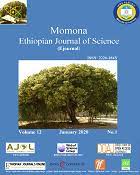Contribution of Participatory Forest Management Program in Non-Timber Forest Products to balance Livelihood Improvement and Conservation: a case of Sera Forest, Amigna District, Southern Ethiopia
Keywords:
Biodiversity, Conservation status, Ethnobotany, Indigenous knowledge, Over-harvesting, PFM, EthiopiaAbstract
Non-Timber Forest Products (NTFPs) have a significant role as a local source of medicine, fiber, forage, and sustenance and offer income opportunities mainly in rural families. As sustainable use of NTFPs is imperative to provide ecosystem services and biological resources, this study focused on the identification and documentation of plant species used for NTFPs, their availability, and conservation status in Sera Forest, Oromia Regional State, Ethiopia. The study applied a combination of plant ecological and ethnobotanical methods. Ethnobotanical data were gathered through semi-structured questionnaires and interviews which involved 206 randomly sampled general and 24 purposively selected key informants, group discussions, guided field walks, and market surveys. Data were analyzed and presented using analytical methods of ethnobotany, including descriptive statistics, informant consensus factor (ICF), and ranking. Species diversity, richness, and evenness were also computed using Shannon–Wiener diversity indices. A total of 137 plant species belonging to 49 families used as a source of NTFPs were documented from the study area. Eleven major use categories of the NTFPs were identified. Out of these, medicine, firewood, charcoal making, and construction materials were the most dominant uses requiring large volumes of NTFPs. Direct matrix ranking of plant species with multipurpose use revealed, that Hagenia abyssinica was ranked highest, followed by Olea europaea ssp cuspidata, Grewia mollis, Croton macrostachyus, Ximenia americana and Carissa spinarum. Local communities of the study area possess rich indigenous knowledge in the regulation of grazing and extraction of forest products, forest patrolling, firebreak clearance and maintenance, selective preservation of tree species and nursery activities focused on the restoration of indigenous woody species, which all help in using their natural resources for sustainable livelihood. Sera forest is rich in NTFP-bearing plants and associated indigenous conservation knowledge. However, nowadays illegal timber extraction, grazing, over-harvesting of NTFPs, farm expansion, and fire hazards are found to be threatening the plant resources, irrespective of the Participatory Forest Management (PFM) principles. Therefore, it is important to have strong evaluation and monitoring mechanisms for setting harvesting quantities and regulating types of collection. Besides developing a sense of ownership, and responsibility, integrating their traditional forest management practices with modern conservation approaches is desirable for higher livelihood outcomes with lower environmental impacts.

